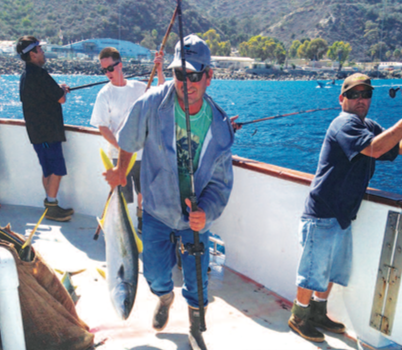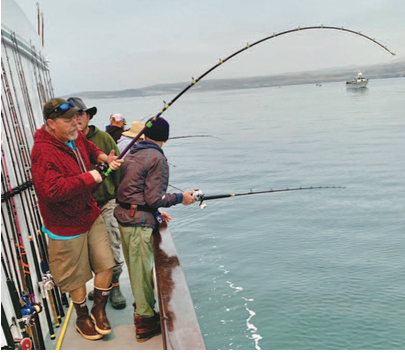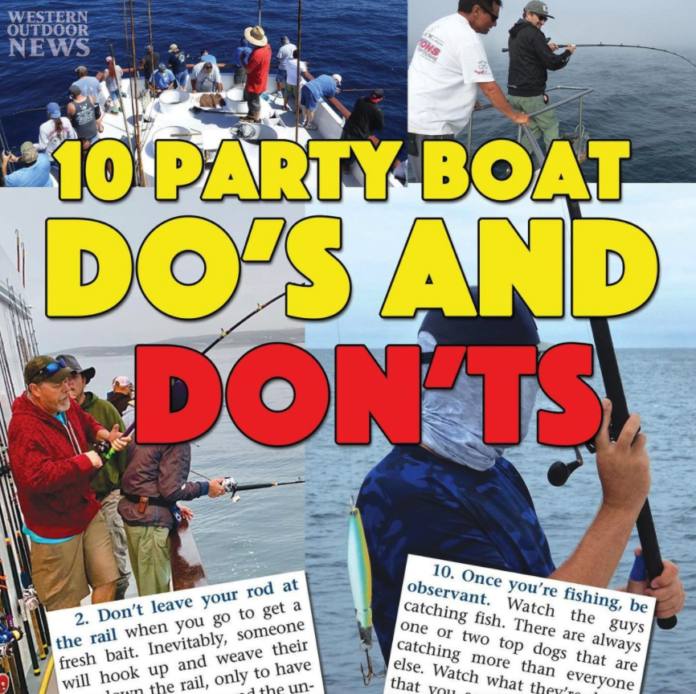BY JON DICKENS
[buzzsprout episode=’9609382′ player=’true’]
You’ve been watching the fish reports, drooling over the thought of getting in on the bluefin tuna bite between the Orange County coast and Catalina Island. You’ve done your honey-do’s and spent extra time with the kids — even took the dog to the vet. Saturday is “your” day, and you can’t wait to get on the water.
You reserved a spot on your favorite party boat a week ago. And yesterday you made your semi-annual contribution at your local tackle shop to make sure you were geared up properly and learn what the fish are biting.
It’s now Friday night and you’re supposed to be sleeping, but you can’t. Your mind is spinning and you hope your reel spool will be doing the same tomorrow. Lying in bed you’ve gone over all the possible scenarios that might occur. You’re ready. You’ve looked at the clock almost every hour in anticipation of the alarm going off. Oh well, you can sleep in on Sunday. Maybe…
You get up before the alarm goes off and shut it off to avoid
waking your wife, but of course, she wakes up anyway. “Good luck. Catch a big one,” she says. And you’re off.
Fast forward past buying your ticket, watching the deckhands load scoops of hot sardines, the great breakfast burrito on the ride out to the tuna grounds, the chum circle… and finally the skipper says, “We’ve got good marks here, let ‘em go.”
Most of the guys and gals on the boat appear to know what they’re doing based on their tackle and the conversations you overheard on the ride across the channel. They’re mostly experienced “regulars” with a mix of weekend warriors and a handful of newbies sprinkled in. They quickly grab baits from the bait wells and cast away.
Uh-oh – “that guy” is on the boat
But then you run into him. “That guy.” He acts like he knows what he’s doing, but obviously doesn’t. He may even be a bit arrogant. He’s standing at the bait tank with two hands flailing about in the well trying to catch a ‘dine. Frustrated, he stabs at a sardine in the next well that you were about to grab, and with his elbows extended, he blocks you out from both wells. Uggh! You walk around to the other side of the bait tank, spot a hot bait and cradle it from the well. He gives up on the good baits and grabs a half dead one because it’s all he could catch and saunters over to the rail. Of course, he parks next to you.
A few big fish boil way back behind the chum line. Everyone’s hoping they charge the boat, but they’re picky and staying well beyond casting range. It’s going to take a long soak to reach them. “That guy” makes his first cast, right over three lines, and then proceeds to drag everyone in for his first of many tangles during the day. No “Oops.” No apology.
The current is now pushing all the lines in the same direction. Those in the know do the “tuna shuffle” and slide along the rail with the current, keeping their lines right in front of them. No angles, no tangles. Everyone except — you guessed it — “that guy.” You politely explain that you have to follow your bait to avoid tangles, just like everyone else is doing. He replies, “I paid for this spot on the boat and I can stay here if I want to.” It’s going to be one of those days.

Don’t be “that guy” who rubs everyone the wrong way. Learn the game and practice good fishing etiquette. And by the way, “that guy” isn’t always a newbie who just doesn’t know any better. Seasoned pros can be “that guy” (or gal). There are those who don’t know, and those who don’t care. Their need to get their fish, catch the most on the boat or win the jackpot, supersedes common courtesy and working together.
10 party boat do’s and don’ts.
So how do you avoid being “that guy?” Here’s a brief list of do’s and don’ts. You may know many of them, but do you practice them? Especially when the bite heats up?
1. Ask questions on the way out to the fishing grounds. Don’t feel embarrassed about ask- ing for advice from the crew or more experienced fishermen. Most everyone is happy to help you get rigged properly, tie a knot, hook a bait, or give you an idea of what to expect during the day.
2. Don’t leave your rod at the rail when you go to get a fresh bait. Inevitably, someone will hook up and weave their way down the rail, only to have to fight their way around the unattended rod. And when you’re at the bait tank, hold your rod vertically so that it doesn’t hit the deckhand who’s chumming on top of the tank or get in the way of anglers at the rail who are casting. Pick the best bait you can and move away from the bait tank quickly so other anglers can get in there. Too many people stay at the bait tank trying to delicately hook their bait and frustrate anglers who are also anxious to get a fresh bait and get back in the water.
3. The guy with the fish on has the right of way. If someone is fighting a fish and is moving towards you, raise your rod, step back and let the angler pass under you. Or if his fish is out away from the boat, let him go over you. You’d want him to do the same when you’re hooked up.

4. If you suddenly “get bit,” be darn sure it’s a fresh fish and not your line tangling around the line of the guy fighting a fish near you. If you set the hook and it’s on his line, you’ll cut him off. Not a way to make friends.
5. Don’t let your hook dangle from your line when you get a bait or the boat is moving to another spot. That’s a disaster waiting to happen. I once saw a dangling jig go flying when we hit a swell and snag an angler right under his eye. The treble hook was in deep and precariously close the eye. The skipper cut the line and taped the jig to the angler’s head to prevent it from moving while the Coast Guard came out to rush him to a hospital. The guy whose jig caused the damage had a pretty miserable day after that too, but learned a valuable lesson. Always secure your hooks on the rod’s hook-keeper, a guide or the reel seat.
6. Do the “tuna shuffle.”
Tuna fishing involves stopping on meter or sonar marks, or run-and-gun style fishing — racing to the foamers and breezers — and then drifting on schools of fish rather than the traditional anchoring for structure oriented fish. The old rotation-style of fishing on a party boat, where you fish on a number painted on the rail that corresponds to the number on the tag you got when you bought your ticket, does not apply. Consequently, join the dance and do the aforementioned “tuna shuffle” where you work your way around the boat based on the current and drift. When the skipper stops the boat, he’ll tell everyone which side of the boat to fish on. Follow his directions and stay in front of your line as you move along the rail with everyone else. Unless there’s no current or wind, if you fish on the wrong side, your line will drift under the boat and tangle with lines on the other side. Follow the old adage, “Wind in your face, you’re in the right place.”
7. Don’t jump into the middle of the pack. When drifting and you leave the rail to put on a fresh bait, take your rod with you and then start over at the end of the line, so to speak. Don’t jump into the middle of everyone, or into the corner of the stern (unless they’re your buddies and it’s ok with them), or you’ll hear about it from your fellow fishermen. When everyone plays by the rules, everything goes quite smoothly and you’ll get your chance at the fish.
8. Keep your eye on your hook when casting so you don’t hook someone who may not be watching where they’re going in the heat of the bite. As the saying goes, you can’t miss the ocean. It isn’t moving anywhere, but your hook is. Keep your eyes on your hook during your back cast.
9. Don’t cast a jig in the stern area when everyone’s fishing bait. You’re likely to tangle lines on the retrieve. When the fish are blowing up on bait in the corner it’s tempting to throw the iron, but not appreciated by your fellow anglers. Most boats request that jig throwers do their thing on the bow. And often times that’s the best spot, especially when targeting yellows or tuna as the boat stops on breezing schools.
10. Once you’re fishing, be observant. Watch the guys catching fish. There are always one or two top dogs that are catching more than everyone else. Watch what they’re doing that you aren’t. Maybe they’re belly hooking their sardine, using lighter line or a fluorocarbon leader. Or letting their jig sink down below the fish before retrieving. Be a detective. And don’t be afraid to ask that hot stick or a deckhand, why he’s catching more fish than you. That’s the best way to learn.
Tipping the scales in your favor
Another tip worth mentioning is just that. Tipping. The deckhands and galley crew work hard to make your fishing day enjoyable. They can’t control whether the fish bite, but they can contribute to their customers’ experience. If they’ve worked hard, show your appreciation. They may be working on a boat because they love to fish, but the truth is, they’re not well paid. Gratuities, in addition to fish cleaning fees, are much appreciated. If you plan to fish that boat again, handing the deckhand 10 or 20 bucks this time might get you a tip next time — inside insights as to what’s been working best, or handing you a primo bait they found in the bait tank.
While tipping the captain isn’t expected on party boats, making sure to thank him for a great time when getting off the boat will have him remember you as one of the good guys. On one memorable trip, I think nearly everyone aboard made a point of thanking the captain and crew. But this was no average trip.
It was during the height of El Nino and I was fortunate to be on an afternoon half-day trip on the Monte Carlo out of 22nd Street Landing in San Pedro. That day was the best example of party boat etiquette under extreme circumstances you’ll ever see. I called in the morning to see how many reservations they had and was pleasantly surprised to hear just nine. When I got there though, there were 60 people waiting for the Monte to come in from their morning trip. I almost left. Glad I didn’t.
We hit a spot about 15 minutes from the breakwater that went wide open on yellowtail running 15 to 20 pounds, with a few over 25. By the end of that short afternoon half-day trip, we put 120 yellows on the boat! Pure pandemonium. You can imagine what a mess this could have been. I was lucky to go five-for-five and didn’t lose a fish in a tangle, even with 60 other anglers on the boat. Not everyone knew what to do but they followed the crew’s directions and worked as a team.
On the way in, Walt Pollock, the skipper, got on the P.A. and said this was the best local half-day fishing for big yellows that he’d seen in his 40 years on the water. He made a particular point of congratulating everyone for working so well together during the epic bite. How we got that many fish on the boat, I’m still not sure. The crew did an outstanding job and the fishermen aboard agreed as a group that the jackpot money should go to them as a thank you. “That guy” wasn’t on the boat that day.
No one wants to be known as “that guy.” Unless of course, it’s that guy that not only catches fish, but also shares his knowledge and helps others catch fish. Which “guy” do you want to be?




